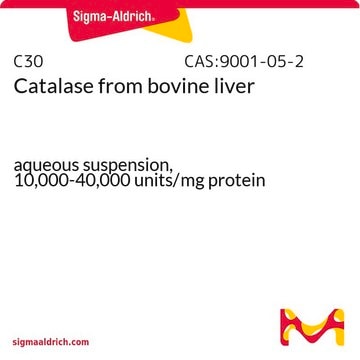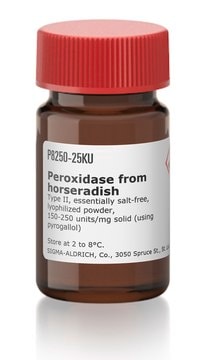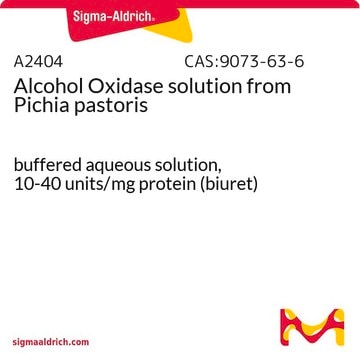G7400
Galactose Oxidase from Dactylium dendroides
lyophilized powder, ≥3,000 units/g solid
Synonym(s):
D-Galactose:oxygen 6-oxidoreductase
Sign Into View Organizational & Contract Pricing
All Photos(3)
About This Item
Recommended Products
biological source
fungus (Dactylium dendroides)
form
lyophilized powder
specific activity
≥3,000 units/g solid
storage temp.
−20°C
Looking for similar products? Visit Product Comparison Guide
General description
Galactose oxidase is an extracellular copper-containing enzyme, secreted by the deuteromycete fungus Dactylium dendroides. It catalyzes the oxidation of a range of primary alcohols, including D-galactose, to the corresponding aldehyde, with reduction of oxygen to hydrogen peroxide.
Application
Galactose oxidase may be used as an analytical tool for the specific determination of D-galactose in blood plasma, plant extracts, and phospholipids. It could be used for the characterization of terminal D-galactoside units in several polymers.
Biochem/physiol Actions
Galactose oxidase catalyzes the coversion of D-galactose to D-galacto-hexodialdose.
2-Deoxy-D-galactose, lactose, melibiose, raffinose and stachyose react with galactose oxidase in the peroxidase:o-tolidine system.
Essentially no oxidation of D-glucose, L-galactose, L-arabinose or D-glucuronate has been observed.
2-Deoxy-D-galactose, lactose, melibiose, raffinose and stachyose react with galactose oxidase in the peroxidase:o-tolidine system.
Essentially no oxidation of D-glucose, L-galactose, L-arabinose or D-glucuronate has been observed.
Unit Definition
One unit will produce a ΔA425 of 1.0 per min at pH 6.0 at 25 °C, in a peroxidase and o-tolidine system. Reaction volume = 3.4 mL. Light path = 1 cm.
inhibitor
Product No.
Description
Pricing
related product
Signal Word
Danger
Hazard Statements
Precautionary Statements
Hazard Classifications
Resp. Sens. 1
Storage Class Code
11 - Combustible Solids
WGK
WGK 1
Flash Point(F)
Not applicable
Flash Point(C)
Not applicable
Certificates of Analysis (COA)
Search for Certificates of Analysis (COA) by entering the products Lot/Batch Number. Lot and Batch Numbers can be found on a product’s label following the words ‘Lot’ or ‘Batch’.
Already Own This Product?
Find documentation for the products that you have recently purchased in the Document Library.
Customers Also Viewed
Yuling Sun et al.
Biomacromolecules, 22(6), 2595-2603 (2021-05-07)
Antifreeze glycoproteins (AFGPs) are able to bind to ice, halt its growth, and are the most potent inhibitors of ice recrystallization known. The structural basis for AFGP's unique properties remains largely elusive. Here we determined the antifreeze activities of AFGP
Bei Yue et al.
Frontiers in pharmacology, 12, 774560-774560 (2021-11-20)
Irinotecan (CPT11), a broad-spectrum cytotoxic anticancer agent, induces a series of toxic side-effects. The most conspicuous side-effect is gastrointestinal mucositis, including nausea, vomiting, and diarrhea. A growing body of evidence indicates that bacteria β-glucuronidase (GUS), an enzyme expressed by intestinal
Sarah E Deacon et al.
Chembiochem : a European journal of chemical biology, 12(4), 593-601 (2011-01-26)
Galactose oxidase (GO) displays broad primary alcohol substrate specificity and so offers potential for engineering new substrate specificity by directed evolution. Producing variant libraries of sufficient complexity ideally requires expression of functional protein in a host such as Escherichia coli.
Oliver Spadiut et al.
Microbial cell factories, 9, 68-68 (2010-09-15)
The microbes Escherichia coli and Pichia pastoris are convenient prokaryotic and eukaryotic hosts, respectively, for the recombinant production of proteins at laboratory scales. A comparative study was performed to evaluate a range of constructs and process parameters for the heterologous
M J McPherson et al.
The Journal of biological chemistry, 267(12), 8146-8152 (1992-04-25)
The gaoA gene, encoding the secreted copper-containing enzyme galactose oxidase, has been isolated from the Deuteromycete fungus Dactylium dendroides. Degenerate oligonucleotide primers were designed from amino acid sequence data for use in the polymerase chain reaction. A 1.4-kilobase DNA fragment
Our team of scientists has experience in all areas of research including Life Science, Material Science, Chemical Synthesis, Chromatography, Analytical and many others.
Contact Technical Service














